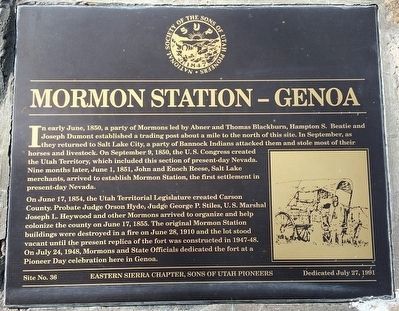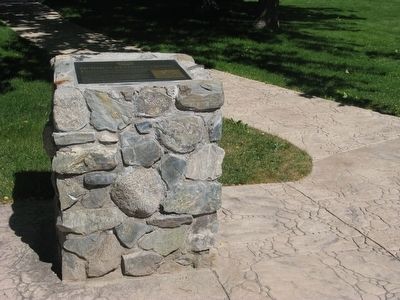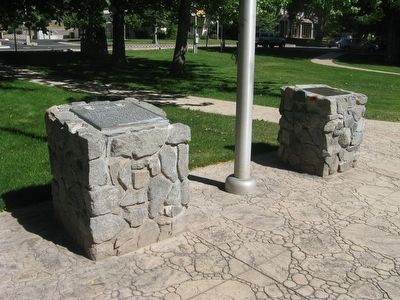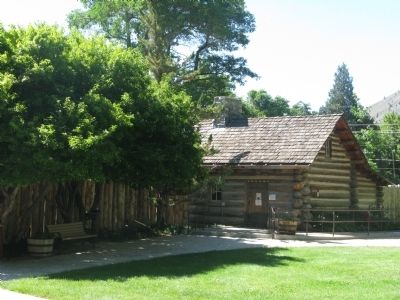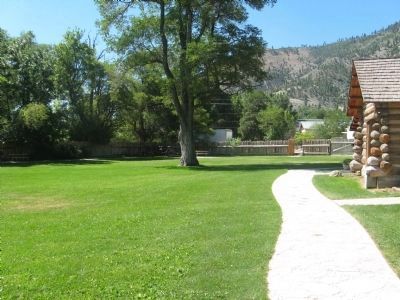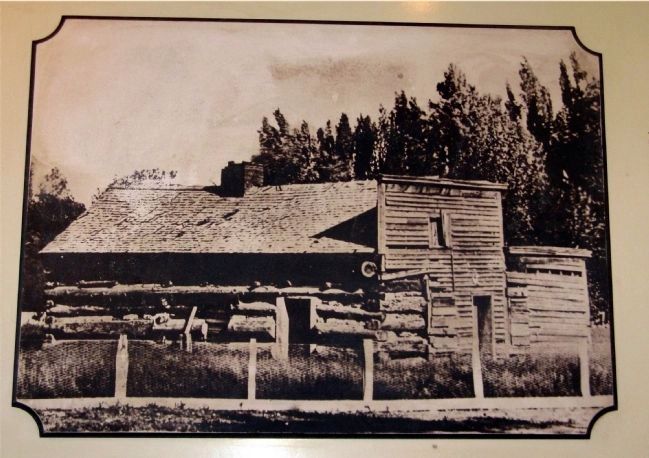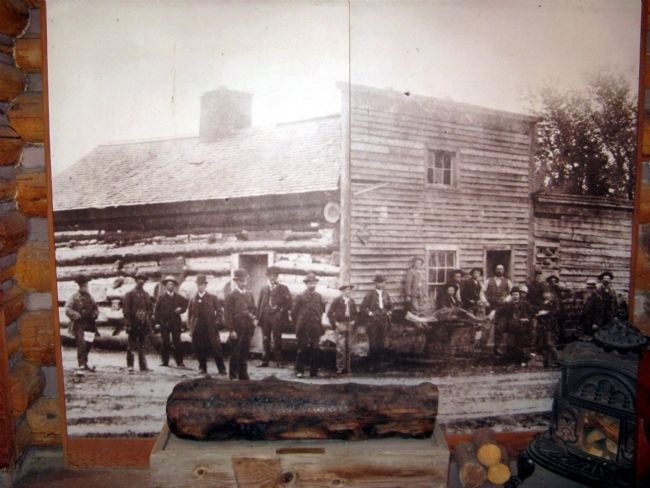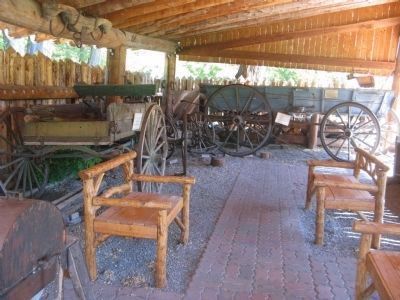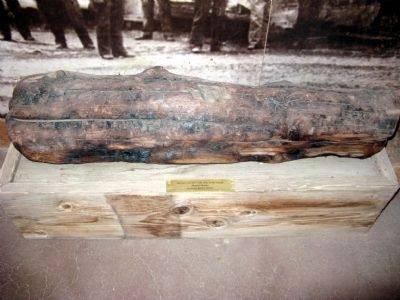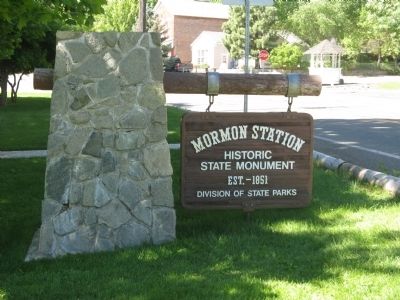Genoa in Douglas County, Nevada — The American Mountains (Southwest)
Mormon Station - Genoa
On June 17, 1854, the Utah Territorial Legislature created Carson County. Probate Judge Orson Hyde, Judge George P. Stiles, U.S. Marshall Joseph L. Heywood and other Mormons arrived to organize and help colonize the county on June 17, 1855. The original Mormon Station buildings were destroyed in a fire on June 28, 1910 and the lot stood vacant until the present replica of the fort was constructed in 1947-48. On July 24, 1948, Mormons and State Officials dedicated the fort at a Pioneer Day celebration here in Genoa.
Erected 1991 by Eastern Sierra Chapter, Sons of Utah Pioneers. (Marker Number 36.)
Topics and series. This historical marker is listed in these topic lists: Churches & Religion • Industry & Commerce • Native Americans • Settlements & Settlers. In addition, it is included in the Sons of Utah Pioneers series list. A significant historical year for this entry is 1850.
Location. 39° 0.248′ N, 119° 50.746′ W. Marker is in Genoa, Nevada, in Douglas County. Marker can be reached from Jacks Valley Road/Main Street (Nevada Route 206) near Genoa Lane. Marker is located at the Mormon Station Historic State Monument. Touch for map. Marker is in this post office area: Genoa NV 89411, United States of America. Touch for directions.
Other nearby markers. At least 8 other markers are within walking distance of this marker. Mormon Station (here, next to this marker); Mormon Station State Historic Park (a few steps from this marker); About Your Journey... (within shouting distance of this marker); John A. “Snowshoe” Thompson (within shouting distance of this marker); Welcome to Mormon Station State Historic Park (within shouting distance of this marker); We Made It! The End of the Great Basin (within shouting distance of this marker); Carson Trail - Original Mormon Station (within shouting distance of this marker); The Journey Through Nevada (within shouting distance of this marker). Touch for a list and map of all markers in Genoa.
Regarding Mormon Station - Genoa. For additional information, links and photos, see "Nearby Marker" also named Mormon Station.
Additional commentary.
1. Mormon Station State Historic Park
[From the Mormon Station State Historic Park Brochure.]
The discovery of gold at Sutter’s Mill in 1848 started the frantic migration west to California. After facing many challenges along the journey, the final obstacle on the California Trail was tackling the Sierra Nevada Mountains. Weary and thirsty travelers often rested and purchased supplies in the fertile oasis of the Carson Valley.
In June of 1850, two members of the Mormon Battalion, Abner Blackburn and Hampton Beatie, established a temporary trading post on the west side of Carson Valley. Their stories of this beautiful area on the emigrant trail intrigued their Salt Lake employer, John Reese, and his nephew, Stephen Kinsey.
In the spring of 1851, Reese and Kinsey loaded more than a dozen wagons full of supplies and set out for the Carson Valley. The Reese Company built a permanent trading post, approximately one mile south of the temporary trading post established by Blackburn and Beatie. Reese’s Station, later renamed Mormon Station, soon had a blacksmith shop, livery
stable, and flour and saw mills nearby.
— Submitted July 29, 2009, by Syd Whittle of Mesa, Arizona.
2. Tying a Nation Together - (See Photo #6)
The Overland Trail
The prairie schooner, with its bowed staves and canvas cover, was the mainstay for land transportation along the 2,000-mile Overland Trail during the first decade of Mormon Station’s existence. The 500-mile stretch from Salt Lake City to Carson Valley took its toll of men, animals, and equipment, turning the sunbaked salt flats of Carson Sink into a gigantic graveyard:
..shallow graves, the bleaching skeletons of 1,200 animals, abandoned household goods, beds and bureaus, stoves and trunks, and finally the wagons themselves, their canvas and staves bleaching like the white bones of played-out animals. - Irving Stone - Men to Match My Mountains.
The Pony Express
The need for faster communication spawned the Pony Express, an ambitious and daring venture that began operations on April 3, 1860 and ran between St. Joseph, Missouri and Sacramento, California. Mail between those two points was carried in 10 days flat, compared with several months by wagon. Although it lasted only 18 months, the Pony Express was a romatic chapter in history and the tales of courageous
and hardy riders are legend. Mormon Station served as one of 190 stations along the route of the Pony Express. The last mail bag was delivered on October 28, 1861, by which time the Pony Express had been made obsolete by the transcontinental telegraph.
The Telegraph
Speedier and more efficient communications always in demand, especially in the West, and Frederick A. Bee, a Sacramento businessman, was quick to see the future of the telegraph. On July 4, 1858, Bee’s Company, the Pacific, Humbolt & Salt Lake Telegraph Company, began stretching wire through the treetops of Genoa. People called it “Bee’s Grapevine Line,” but it quickly proved its ability to communicate rapidly over long distances and inhospitable terrain. As Bee’s wires stretched eastward from Carson Valley, they narrowed the gap in the East-West line, meeting their eastern counterpart in Salt Lake City on October 24, 1861.
The Stagecoach
Transcontinental stage service along the Overland Trail evolved out of several competing stagecoach companies. The Pioneer Stage Company, operating between Placerville and Carson Valley, became a part of the expanding transportation empire of Wells Fargo & Company. Wells Fargo’s line from California to Salt Lake City connected with Ben Holladay’s Overland Mail and Express Company, which too was bought out by Wells Fargo in 1866. During the 1860’s the Overland stage lines ran through Genoa, with the Carson Valley community serving as a stopping place. By 1869, the stages had been displaced in long-haul travel by the newly completed railroad.
The Railroad
Concurrent with the dream of a transcontinental telegraph, railroad companies had the vision of iron tracks spanning the continent as early as the 1850s. The Civil War gave added impetus to such a line, and in 1862 a government subsidy breathed life into the dream of a Pacific Railroad.
Two railroads began work, the Central Pacific moving eastward from Sacramento, and the Union Pacific laying track up the Platte Valley from Omaha. On May 10, 1869 the two lines met in Promontory, Utah. A Golden spike was driven with great ceremony, followed by “a scene of general hilarity.” The coasts of the nation were now linked by the most modern transportation form yet known to man.
With the coming of the railroad, which passed along the Truckee River some 50 miles to the north, Mormon Station found itself off the principal route of transcontinental travel.
Genoa’s First Newspaper
Genoa also saw the birth of one of Nevada’s earliest newspapers when Stephan A. Kinsey published a few issues of The Scorpion. This handwritten newspaper was founded and failed in 1857. The following year, the Territorial
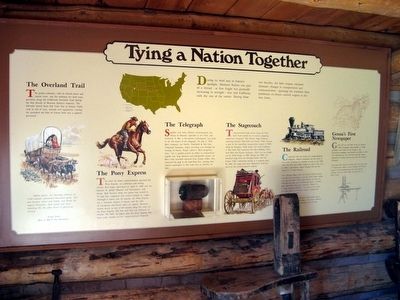
Photographed By Syd Whittle, July 25, 2009
6. Tying a Nation Together
[This is one of many interpretive panels on display in the museum highlighting the history of Mormon Station and the town of Genoa.]
During its brief stay in history’s spotlight, Mormon Station was part of a thread – at first fragile but gradually increasing in strength – that tied California with the rest of the nation. During those two decades, the little outpost witnessed dramatic changes in transportation and communication – spanning the transition from ponderous ox-drawn covered wagons to the iron horse.
See Comment #2
During its brief stay in history’s spotlight, Mormon Station was part of a thread – at first fragile but gradually increasing in strength – that tied California with the rest of the nation. During those two decades, the little outpost witnessed dramatic changes in transportation and communication – spanning the transition from ponderous ox-drawn covered wagons to the iron horse.
See Comment #2
The paper later moved to Carson City, and from there to Virginia City, where it was to flourish and become famous as the sounding board for young Samuel Clemens, who won fame under the pen name of Mark Twain.
— Submitted July 29, 2009, by Syd Whittle of Mesa, Arizona.
Credits. This page was last revised on December 21, 2020. It was originally submitted on July 10, 2009, by Syd Whittle of Mesa, Arizona. This page has been viewed 3,886 times since then and 50 times this year. Photos: 1. submitted on October 8, 2015. 2, 3, 4. submitted on July 10, 2009, by Syd Whittle of Mesa, Arizona. 5, 6, 7, 8, 9, 10. submitted on July 29, 2009, by Syd Whittle of Mesa, Arizona. 11. submitted on July 10, 2009, by Syd Whittle of Mesa, Arizona.
